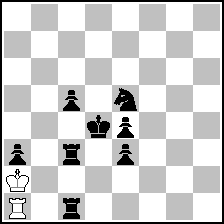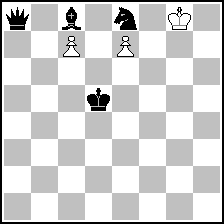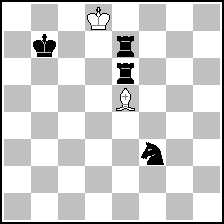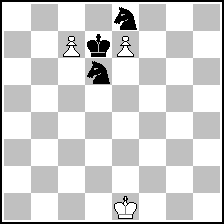|
| Page: [Previous] [Next] 1 2 |
| (1) Posted by Miguel Ambrona [Tuesday, Mar 2, 2021 15:51] |
h#3 (unique solution)
Hi, I wanted to share this helpmate in 3 that I composed some time ago:
 (= 2+4 ) (= 2+4 )
|
|
| (2) Posted by Frank Richter [Tuesday, Mar 2, 2021 17:15] |
Nice, and it took some time to solve it from screen ...
You should look for a twin, it's not very difficult to find phase b) with a different promotion by shifting the black king.
|
|
| (3) Posted by Miguel Ambrona [Tuesday, Mar 2, 2021 17:19] |
I am glad you liked it!
What is a twin?
|
|
| (4) Posted by Andrew Buchanan [Tuesday, Mar 2, 2021 18:49] |
A twin is a second problem, usually with the same stipulation, and most often by shifting one piece to another square. This is particularly common for helpmates. So the stipulation would be: "h#3 (b) bK->??" where "??" should be replaced by a nearby square. Other kinds of twins involve removing a piece, adding a piece, changing a piece or changing a stipulation
|
|
| (5) Posted by Jakob Leck [Tuesday, Mar 2, 2021 19:43] |
Nice and tricky. :) Just to add to what Andrew said about twinning, here is one of the most famous examples: https://pdb.dieschwalbe.de/P0501066
The state of the art in helpmate composition has progressed so far that today it is highly unusual for short helpmates to be published with a single solution. But that shouldn't stop you from enjoying short single-solution helpmates with a nice idea. ;) Of course two or more solutions are better if they show some nice analogy, but adding a solution for the sake of adding a solution can ruin a problem.
|
|
| (6) Posted by Joaquim Crusats [Tuesday, Mar 2, 2021 19:50] |
Miguel, feel free to get in touch with SEPA (Sociedad Española de Problemistas de Ajedrez) at: http://sepa64.blogspot.com/
We are currently running a thematic informal tourney for helpmates. You can also contact me (joaquimchessproblemATgmail.com) if you need more information about the society.
|
|
| (7) Posted by Miguel Ambrona [Wednesday, Mar 3, 2021 12:43] |
Thanks for the explanations about twinning!
I understand now, it seems quite complex to design a puzzle with a meaningful twin.
I guess in the above puzzle, with the bK -> g6 or with bK -> g8 we would also have a unique h#3, but the solution is not that nice, since it involves queening.
@Jakob Leck: Do you mean that a helpmate puzzle should (nowadays) not be unique (multiple solutions) or is it that it should come with a twin?
@Joaquim Crusats: Thanks for the info, it looks very interesting and I didn't know about it!
|
|
| (8) Posted by Jakob Leck [Wednesday, Mar 3, 2021 21:19] |
Usually short helpmates today have several so-called "phases", which can be
1)solution and set play (something like https://pdb.dieschwalbe.de/P0572335)
2)twins like in the example by Forsberg
3)multiple solutions in one position (e.g. https://pdb.dieschwalbe.de/P0500222).
Set play is a little bit out of fashion today and multiple solutions are considered superior to twinning because it is in some way more economical to not change the position. But you will still find examples for all three types published regularly. (And maybe I should add that of course solutions are indeed required to be unique. If it is intended by the author that a position has multiple solutions, this has to be mentioned in the stipulation, i.e. "h#2 3 solutions" or something like that.)
And the degree to which solutions show thematic analogy varies from
a)(almost) completely symmetric solutions (which I think are pointless)
b)solutions with a nice analogy (in theme, e.g. https://pdb.dieschwalbe.de/P0506222, or mate image, e.g. https://pdb.dieschwalbe.de/P0500053)
c)solutions with a theme that is "spread" over multiple solutions (e.g. https://pdb.dieschwalbe.de/P0500540)
d)limited degree of analogy of the solutions
e)very little or (almost) no analogy. (e.g. https://pdb.dieschwalbe.de/P0500524)
Feel free to explore... :)
Then, of course, there are long helpmates which more often have only one solution. But sometimes you have a short idea where you think no twin or second solution fits in, e.g.
Jakob Leck
Rhein-Neckar-Zeitung 21.04.2018
 (= 2+8 ) (= 2+8 )
h#3
|
|
| (9) Posted by Hauke Reddmann [Wednesday, Mar 3, 2021 22:03] |
Same from here, my only (?!) h# I ever did was
one-phased. It's interesting that "mandatory"
twinning/multiple solution occurs only in the
h# genre, whereas it is rather non-standard
in the # or s#, and nonexistent (to my best
knowledge) in the study.
|
|
| (10) Posted by Olaf Jenkner [Wednesday, Mar 3, 2021 23:20] |
Jacob gave good examples to show the beauty of helpmates.
I wonder which problems were superior to Maslar's masterpiece (https://pdb.dieschwalbe.de/P0506222) awarded with the 3rd commendation.
|
|
| (11) Posted by Viktoras Paliulionis [Thursday, Mar 4, 2021 00:02] |
This Maslar's helpmate is only an improvement of his previous work, and therefore only such an award:
http://helpman.komtera.lt/definition/Maslar_theme
|
|
| (12) Posted by Joost de Heer [Thursday, Mar 4, 2021 07:57] |
@Jakob: Your composition has a set play with rook reversal. And the Krikheli has a matching theme in both solutions: A piece can move to a square directly, but has to make a detour to allow the black king to pass a guarded square.
|
|
| (13) Posted by Kenan Velikhanov [Thursday, Mar 4, 2021 09:54] |
Dear Viktoras, my task was awarded with a special prize. 8/4np2/2p5/4k3/6B1/3R1p2/5N2/Kb3qr1
|
|
| (14) Posted by Miguel Ambrona [Thursday, Mar 4, 2021 13:58] |
Thank you so much Jakob Leck (and all of you) for the nice explanations!
I will try to design some nice multi solution helpmate.
|
|
| (15) Posted by Neal Turner [Thursday, Mar 4, 2021 15:28] |
I once made a short one-liner - enjoy:
Problemist Supplement 1995
 (= 3+4 ) (= 3+4 )
h#3
If Miguel wants to find more about helpmates he can't do better than Chris Feather's 'Black to Play' which can be downloaded from here:
https://juliasfairies.com/articles/black-to-play/
|
|
| (16) Posted by Jakob Leck [Friday, Mar 5, 2021 11:58] |
You're welcome, Miguel. :) I agree with Neal's recommendation of 'Black to play' - an excellent book!
@Joost: Thanks for your remark. I can't remember whether I had seen the set play before publishing the problem because I don't keep detailed record of my ideas, but I'd guess I did. While the rook reversal is quite nice, the set play is essentially the solution minus a tempo so that the similarities are far to great for my liking. And it doesn't add that much to the main point of the problem, the r-r-Klasinc, so I prefer it without the set play.
|
|
| (17) Posted by Viktoras Paliulionis [Friday, Mar 5, 2021 13:08] |
@Jakob: With the set play, additionally the Larsson theme would be:
http://helpman.komtera.lt/definition/Larsson_theme
My example with R-R Klasinc:
Viktoras Paliulionis
StrateGems 2019
 (= 2+4 ) (= 2+4 )
h#7
1.Rh7 Bg7 2.Re8+ Kd7 3.Se5+ Kd6 4.Sd7 Be5 5.Kc8 Kc6 6.Kd8 Kb7 7.Rhe7 Bc7#
1.Re8+? Kd7 2.R6e7+ Kd6 3. Kc8 Kc6 4.Kd8 Bb8(B~) 5.Se5+ Kb6 6.Sd7 Kb7 7.?? Bc7# - Black lacks a tempo move.
Tempo + Klasinc bR-bR and wB-bS.
|
|
| (18) Posted by Marjan Kovačević [Friday, Mar 5, 2021 14:26] |
Neal, I liked your problem!
Such a wonderful eye-catching position and a tricky solution!
|
|
| (19) Posted by Alain Villeneuve [Friday, Mar 5, 2021 18:35] |
I liked it too. It makes me think of this one (Bo Lindgren 1999) : I took 15 minutes for the (b) but 4 times more (!) for the (a).
 (= 3+3 ) (= 3+3 )
h#3
b) BBc8.
|
|
| (20) Posted by Kenan Velikhanov [Friday, Mar 5, 2021 19:24] |
Thank You very much, Viktoras!
|
|
Read more... |
Page: [Previous] [Next] 1 2
MatPlus.Net  Forum Forum  Helpmates Helpmates  h#3 (unique solution) h#3 (unique solution) |
 ISC 2024
ISC 2024 Forum
Forum  Helpmates
Helpmates  h#3 (unique solution)
h#3 (unique solution) 


